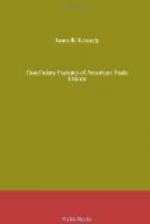1890..24,624 1984..27,828 1898..26,460 1891..24,221 1895..27,760 1899..28,994 1892..26,678 1896..27,318 1900..33,955 1893..26,788 1897..26,347
[Footnote 6: Cigar Makers’ Journal, Vol. 10, Aug., 1885; Vol. 19, May, 1894, p. 8. The records of initiations and suspensions for various periods in the history of the union also show the increase in the power to retain members. During 1877-1879, with only strike benefits in operation, 3000 members were initiated and 2750 were suspended; from September, 1879, to September, 1880, with strike and travelling benefits in force, 5453 were initiated and 1853, or 33.9 per cent., were suspended, while from September, 1880, to September, 1881, when a sick benefit was also being paid, 7402 were initiated, and 1867, or 25.2 per cent., were suspended. (Cigar Makers’ Journal, Vol. 6, June, 1881, p. i; Vol. 7, October, 1881, p. 3.)]
The Typographia, the only other American trade union which has developed its system of benefits as fully as the Cigar Makers, held its membership equally well during the depression of 1893-1897. The following table shows the membership of the Typographia from 1890 to 1900 by years:
1890 ...1233 1894 ...1204 1898 ...1100 1891 ...1322 1895 ...1092 1899 ...1071 1892 ...1382 1896 ...1115 1900 ...1044 1893 ...1380 1897 ...1083
The falling off in membership in 1894 and 1895 was due only to a very small extent to defections. The introduction of the linotype decreased the opportunity for employment in the trade, and the gradual shrinkage in the amount of German printing done in the United States due to the falling off in German immigration was accentuated by the depression.
While the two unions having the most highly developed beneficiary systems thus show an ability to retain members during periods of depression, it would be absurd to assume that this result is solely the effect of the establishment of the benefits. The Cigar Makers’ Union in 1892 would undoubtedly have held its membership better than it did in 1872 even if it had developed no benefits. It is interesting in this connection to note that while in the depression of 1873-1878 the membership of the Typographical Union fell from 9799 to 4260, a loss of forty per cent., and the number of local unions decreased from 105 to 60, in the great depression of 1893-1897 the membership fell from 31,379 in 1894 to 28,096 in 1897, a loss of only ten per cent. Part even of this small loss was due to the withdrawal of the pressmen and bookbinders from the organization. It thus appears that the Typographical Union with a death benefit of sixty-five dollars and a home for the aged held its membership almost as well as the Cigar Makers with their much more highly developed beneficiary system. The change in the power of the Typographical Union to retain its membership was obviously due not so much to the establishment of beneficiary features as to the greater support which it gave its members in collective bargaining.




